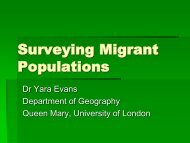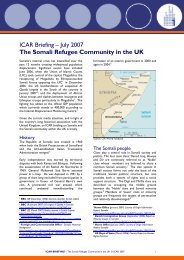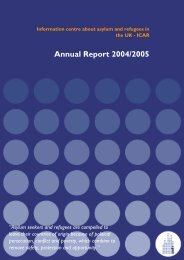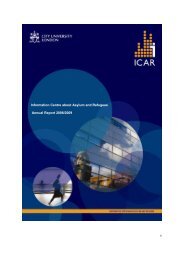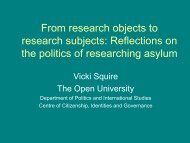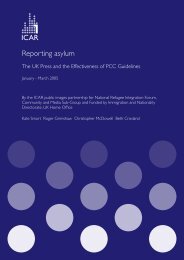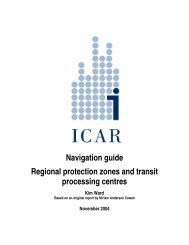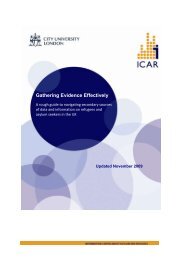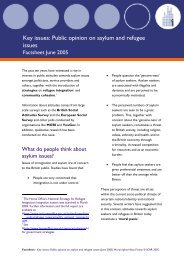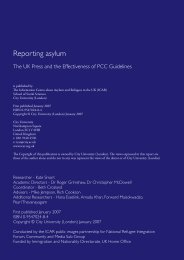Uncovered: assessing media and communications needs ... - ICAR
Uncovered: assessing media and communications needs ... - ICAR
Uncovered: assessing media and communications needs ... - ICAR
- No tags were found...
You also want an ePaper? Increase the reach of your titles
YUMPU automatically turns print PDFs into web optimized ePapers that Google loves.
3 FINDINGS3.1 IntroductionThis section presents data gathered through the online questionnaire, which produced a total of 117responses. Additional comments are included from individual interviews <strong>and</strong> focus group discussions.The full text of the survey can be found in Appendix 3. Responses have been organised according tothe sector categories refugee <strong>and</strong> migrant, black <strong>and</strong> minority ethnic (BME), faith, ‘isolated rural’ <strong>and</strong>‘other’.Respondents self-selected themselves into these categories with 37 of them classifying themselvesas ‘other’. Respondents selecting the ‘other’ category included six race equality organisations, <strong>and</strong>eight from groups such as breast cancer support, or Parkinson Disease Society which are based inrural areas but part of larger networks. There were two country specifi c (Zimbabwe) organisations, fi veinfrastructure bodies serving all rural areas (ie. including ‘isolated rural’), one women’s group <strong>and</strong> atrades union. One described itself as a ‘Christian charity’ <strong>and</strong> another as an ‘interfaith’ group.‘Other’ respondents mentioned above also ticked additional specifi c categories. Five selected‘isolated rural’, fi ve ticked BME, one chose faith <strong>and</strong> two ticked refugee/migrant. 27 of those choosing‘other’ made no additional selection.Respondents were given the opportunity to choose more than one option to describe theirorganisation type. Of those selecting more than one option four chose faith <strong>and</strong> BME, fi ve chose BME<strong>and</strong> refugee/migrant, two chose BME, refugee/migrant <strong>and</strong> rural, <strong>and</strong> one selected all four.The graphs are presented mainly according to percentages of those responding in the differentcategories. The actual numbers represented by those percentages are: faith 23; BME 26; refugee/migrant: 34; isolated rural: 18; other: 37.Analysis of answers are divided into two parts: general observations <strong>and</strong> disaggregated observations(by organisation type).3.2 Type of organisations responding to the surveyRefugee <strong>and</strong> migrant worker organisations in the sample have the highest proportion of volunteersagainst paid members of staff, followed by BME organisations. This is likely to have implicationsthroughout the survey because the organisation may be less able to afford training, or to have timeto attend training, but are likely to have a greater need for it, for example as a result of having fewerspecialist staff.Refugee <strong>and</strong> migrant worker organisations also have few members of paid staff, suggesting <strong>media</strong>work might be spread more thinly while staff concentrate on the core tasks that all organisationsmust complete – such as funding, administration, project work, etc. An exception however may befaith groups which may be more likely to attract volunteers willing to work in their free time. Biggerorganisations are more likely to have staff that can undertake tasks additional to core organisationfunctions <strong>and</strong> there is a greater possibility that there will be <strong>media</strong> skills. This coheres with the fi nding(in 3.5 below) that refugees <strong>and</strong> migrants are less likely to be in contact with their local <strong>media</strong> <strong>and</strong> areless likely to know how to contact the <strong>media</strong> than any other organisation type.The large numbers of organisations with paid staff reported by those responding under the ‘isolatedrural’ category is likely to refl ect the point made in section 1.2.4 above, that some respondents arefrom organisations with a wider remit than just ‘isolated rural’ groups. Feedback from focus groups<strong>and</strong> telephone interviews suggests that many groups operating in isolated rural areas have few or nopaid staff, <strong>and</strong> run under similar constraints to others in the survey.<strong>Uncovered</strong>: <strong>assessing</strong> <strong>media</strong> <strong>and</strong> <strong>communications</strong> <strong>needs</strong> <strong>and</strong> capacity of marginalised communities17





